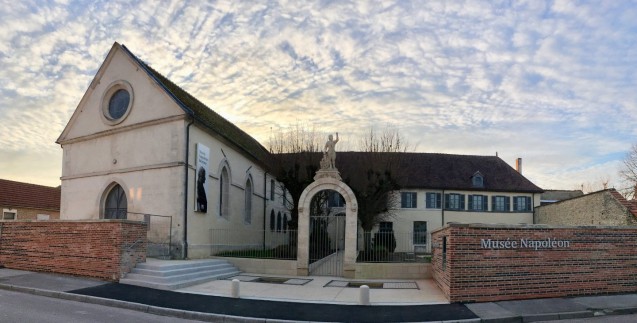It was at the Military School in Brienne, in the Champagne region of France, that Napoleon Bonaparte spent part of his youth, from May 1779 to October 1784. Brienne had been chosen by Count de Saint-Germain, the Secretary of State for War, as one of the twelve preparatory schools for the main Military Academy in Paris. Administered by monks of the order of St. Benedict, the school in Champagne received 60 pupils (known as ‘pensionnaires’) from moneyed families and 60 scholarship boys chosen from amongst the poor aristocracy. Napoleon was one of the latter sort and received a bursary from the crown to finance his education. Apart from the courses on military fortifications, the lessons taught at the school were entirely traditional, namely French, Latin, Maths, History-Geography, Drawing, Music and Fencing.
As specified by the school rules, the young Bonaparte was cut off from his family for five years. School life was purposefully austere, the discipline was severe, and the climate in the Champagne region (particularly harsh in Winter) made the small, unheated, almost monastic cells in which the pensionnaires lived especially unpleasant.
In addition to being isolated from his family he was also deprived of political, social and linguistic stimuli. Considered an upstart from a conquered country (he spoke a thick Corsican dialect and very poor French), Napoleon battened down the hatches and took refuge in his studies, in great distrust of his peers who bullied him. The famous nick-name “straw nose” and the episode of the snowball fight at the beginning of 1784 (the first recorded Napoleonic fight) are but two of the many anecdotes about the life of the future emperor in his school years.
Having passed his artillery exams, Napoleon left Brienne on 30th October 1784 to go to the Military Academy in Paris. He was not return again until 1805, at the time when he was on his way to Milan to be crowned King of Italy. The school had closed however in 1790 following partial destruction during the Revolution. And although Napoleon was to grant 12 000 Francs to the Mayor for repairs, these were never begun. The emperor returned one more time to Brienne in 1814, when he made the château his headquarters during the Battles of Brienne and Rothaire. Thus, completely by chance, the town of Brienne was linked to three of the most symbolic moments of Napoleon’s life. And it was to play one final role, when from Saint Helena Bonaparte bequeathed a million Francs to the town. It was Napoleon III who spent 100 000 Francs of the inheritance building the town hall. For the opening in 1859, a statue of Bonaparte by Rochet, showing Napoleon aged 15 dressed in the Military School uniform, was erected in front. The podium of the statue bears an inscription recording the homage rendered by Napoleon to the town which was so significant for him and it reads: As regards my thinking, it is not Corsica but Brienne that is my native land, because it was there that I formulated my first opinions of mankind.
The Museum of Napoleon 1st in Brienne, opened in what was left of the Military School in 1969, comprises three rooms. The first, the old staff refectory, takes as its theme school life and organisation, and Napoleon’s time there. On show is his registration form filled in by his father, Charles. The two other rooms chart the French Campaign of 1814, with maps, dioramas and engravings showing the different phases of the battles. Arms, ammunition, uniforms and complete kit from these battle sites complete the exhibition. Of particular interest is the statue of Napoleon above the entrance to the school and the plaque listing the names of the pupils who graduated from the school between 1776 and 1790.
Karine Huguenaud
[Update: In January 2018, the museum re-opened with a brand new design]


